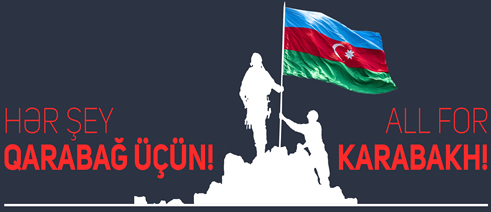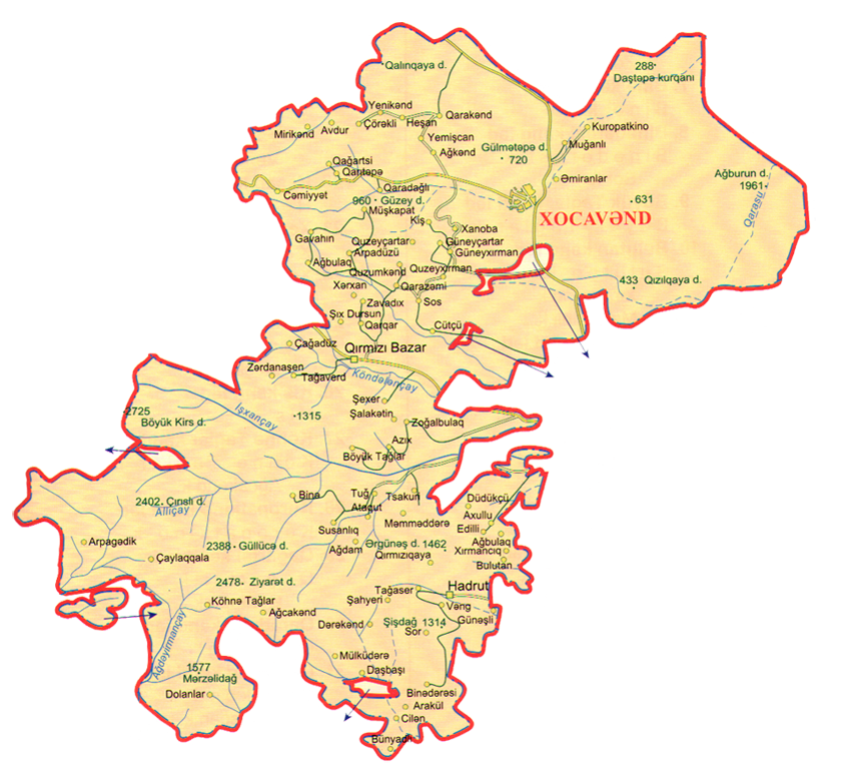


Region Khojavand was established on the basis of Martuni and Hadrut regions on 26 November, 1991, after the liquidation of Nagorno-Karabakh autonomous region. Area of the region is 1.46 thousand square kilometers, population is 44,1 thousand (01.01.2020) people. The distance between Khojavand and Baku is 334 kilometers. Khojavand combines 1 city (Khojavand), 2 big towns (Hadrut and Girmizi Bazar), and 81 villages. Its villages are – Shekher, Shıkh Dursun, Dagdoshu, Edisha, Gırmızıgaya, Gochbayli, Tagaser, Vang, Agkand, Akhullu, Arakul, Bunyadlı, Jilan, Dashbashı, Zardanashen, Mushkapat, Kish, Kohna Taglar, Yemishjan, Gargar, Kharkhan, Zavadıkh, Tagaverd, Chagaduz, Mulkudara, Arpaduzu, Azıkh, Zogalbulag, Bina, Binadarasi, Sor, Boyuk Taglar, Bulutan, Khırmanjig, Malikjanlı, Jamiyyat, Chaylaggala, Arpagadik, Petrosashen, Chiraguz, Mammaddara, Tsakuri, Darakand Agjakand, Hakaku, Gagartsi, Guzumkand, Garazami, Mirikand Avdur, Tug, Atagut, Kuropatkin, Shahyeri, Dolanlar, Edilli, Agbulag, Dudukchu, Amiranlar, Gavahın, Agbulag, Guneykhırman, Chorakli, Guzeychartar, Guzeykhırman, Gunashli, Gushchular, Heshan, Khanoba, Khojavand, Kandkhurd, Garıtapa, Garadaglı, Garakand, Muganlı, Salakatin, Sos, Jutju, Susanlıg, Yenikand, Guneychartar. Khojavand possesing favourable geographical position and conditions is neighbouring with Agdam, Agjabadi, Fuzuli, Jabrail, Gubadli, Lachin, Shusha, Khojaly. Its name consists of 2 parts: ”Khoja” and “vand”. Khoja means “teacher” in turkish language. Vand means “child,descent” in Persian. Khojavand is mostly region of agriculture. Vine-growing, graining stock-raising are important part of its economy. Moutainous rivers in the region alongwith beauty created favorable conditions for gardening and melon-plantation. From ancient times local people here have planted orchards and have been engaged in farming.
Region is located at the edge of Agdam-Fuzuli road and is foothill plain. Relief is mostly mountainous. Height is approximately between 500 meters and 2725 meters (Big Kirs). There are tens of recreational zones in the region such as Bagirkhan, Girmizi Bazar, Mada spring, Baba spring, Balli Spring etc. As an ancient settlement place Khojavand has unique natural resources, monuments and resources such as Edish gabbro with capacity of 2034 thousand cubic metres and suitable for production of facing stone, limestone deposits of 989 thousand tons, suitable for limestone production, underground fresh water deposits of 90,33 thousand cubic meters a day. Rivers such as Khonashenchay, Kondalanchay, Gozluchay, Guruchay, Chaxmagchay, Alıchay, Atautchay, Binachay belong to Kura-Araz basin.
One East plane tree 1000 years old with diameter of 600 santimeters, height of 25 meters, and one 2000 years old with diameter of 600 santimeters, height of 25 meters in the town Girmizi bazar of Khoajavan were protected. In the village Garakand 100 years old zelkova trees which were one of the species of III era with diameter of 24 sm, height of 12 meters were protected. Region is situated in the edge of Agdam-Fuzuli road and is foothill plain. Its relief is mostly mountainous. Its Height is roughly between 500 meters and 2725 meters (Big Kirs) . As an ancient settlement place Khojavand has unique natural resources, monuments and resources such as Edish gabbro with capacity of 2034 thousand cubic metres and suitable for production of facing stone, limestone deposits of 989 thousand tons, suitable for limestone production, underground fresh water deposits of 90,33 thousand cubic meters a day. Vegetation composition is mainly comprised of shrubbery and sparsely wooded meadows. One East plane tree 1000 years old with diameter of 600 santimeters, height of 25 meters, and one 2000 years old with diameter of 600 santimeters, height of 25 meters in the town Girmizi bazar of Khojavand were protected. 100 years old zelkova trees which were one of the species of III era and included to “Red book” had diameter of 24 sm, height of 12 meters and they were protected in the village Garakand of Khojavand. Region is situated in the edge of Agdam-Fuzuli road and is foothill plain. Its relief is mostly mountainous. There are historical art and architectural monuments in Khojavand such as 1,5 years old cave “Azikh” , ancient cave “Taglar”, in the village Tug, castle “Ritish” remained from V-VIII centuries, “Argunesh” castle on the cliffes of mountain Argunesh, tomb “Rzagulu Bey” from XIII century, cupola “Ashigli Gosha”, temple “Alban” in the village Boyuk Taglar (1241) and temple “Girmizi” from X century. Begining from February, 1988 Khojavand gave 145 martyrs during Karabakh war (13 women, 13 children). Khojavand was occupied by Armenian military forces on October 2, 1992.
9 October 2020 - Hadrut settlement in Khojavend region was liberated from Armenian occupation, as were 35 villages of the region during the Second Karabakh War. Azerbaijan's sovereignty was established over Khojavend, and the territorial integrity of the Republic of Azerbaijan was restored. Karabakh is Azerbaijan!
Source:
Karabakh memory book Baku 2010 MHS-paligraf
Information of State Statistics Committee